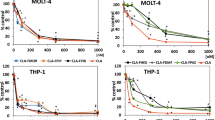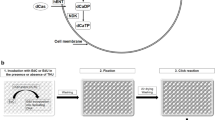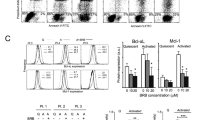Abstract
In leukemic cells exposed to 2-chlorodeoxyadenosine (2-CdA), levels of the nucleoside drug and its phosphate metabolites decay with time in the absence of external 2-CdA; an intrinsic part of this process is the efflux of 2-CdA. The effects of nitrobenzylthioinosine (NBMPR) and of dipyridamole (DPM), both potent inhibitors of es (e, equilibrative; s, sensitive to NBMPR) nucleoside transport processes, were studied in four lines of cultured leukemic lymphoblasts. Suspensions of 2-CdA-loaded cells were diluted 10-fold with 2-CdA-free medium to initiate the cellular 2-CdA decay processes, which followed a biexponential time course. When diluting media contained NBMPR or DPM, intracellular levels of 2-CdA and its metabolites were substantially increased (P < 0.001) compared with cells in media lacking the transport inhibitors, and 2-cda loss followed a monoexponential time course. As a consequence, the aucs (area under time-course plots of intracellular 2-cda and its metabolites) were significantly (P < 0.001) lower in untreated control cells compared to inhibitor-treated cells. These results suggest that nucleoside transport processes contribute to the efflux of 2-cda from the cultured lymphoblasts. The cytotoxicity of 1-h exposure to 2-cda of reh-a2 and ccrf-cem cells was enhanced three-fold by subsequent exposure to 0.5 μM NBMPR relative to that of control cells subjected to the same manipulations without NBMPR exposure. However, before such a strategy may be considered to have a therapeutic application, careful examination of effects in normal lymphocytes and ex vivo leukemic lymphoblasts must first be undertaken.
This is a preview of subscription content, access via your institution
Access options
Subscribe to this journal
Receive 12 print issues and online access
$259.00 per year
only $21.58 per issue
Buy this article
- Purchase on Springer Link
- Instant access to full article PDF
Prices may be subject to local taxes which are calculated during checkout





Similar content being viewed by others
References
Beutler E . New chemotherapeutic agent: 2-chlorodeoxyadenosine Semin Hematol 1994 31: 40–45
Guchelaar HJ, Richel DJ, Schaafsma MR . Clinical and toxicological aspects of the antineoplastic drug cladribine: a review Ann Hematol 1994 69: 223–230
Santana VM, Mirro J Jr, Harwood FC, Cherrie J, Schell M, Kalwinsky D, Blakley RL . A phase I clinical trial of 2-chlorodeoxyadenosine in pediatric patients with acute leukemia J Clin Oncol 1991 9: 416–422
Santana VM, Mirro J Jr, Kearns C, Schell MJ, Crom W, Blakley RL . 2-Chlorodeoxyadenosine produces a high rate of complete remission in relapsed acute myeloid leukemia J Clin Oncol 1992 10: 364–370
King KE, Cass CE . Membrane transport of 2-chloro-2′-deoxyadenosine is required for cytotoxicity Proc Am Assoc Cancer Res 1994 35: 577
Avery TL, Rehg JE, Lumm WC, Harwood FC, Santana VM, Blakley RL . Biochemical pharmacology of 2-chlorodeoxyadenosine in malignant human hematopoietic cell lines and therapeutic effects of 2-bromodeoxyadenosine in drug combinations in mice Cancer Res 1989 39: 4972–4978
Griffig J, Koob R, Blakley RL . Mechanisms of inhibition of DNA synthesis by 2-chlorodeoxyadenosine in human lymphoblastic cells Cancer Res 1989 49: 6923–6928
Saven A, Piro LD . Complete remissions in hairy cell leukemia with 2-chlorodeoxyadenosine after failure with 2′-deoxycoformycin Ann Intern Med 1993 119: 278–283
Hentosh P, Koob R, Blakley RL . Incorporation of 2-halogeno-2′-deoxyadenosine 5′-triphosphates into DNA during replication by human polymerases α and β J Biol Chem 1990 265: 4033–4040
Crawford CR, Ny CYC, Noel D, Belt JA . Nucleoside transport in L1210 murine leukemia cells J Biol Chem 1988 265: 9732–9736
Vijayalakshmi D, Belt JA . Sodium-dependent nucleoside transport in mouse intestinal epithelial cells J Biol Chem 1988 263: 19419–19423
Williams TC, Jarvis SM . Multiple sodium-dependent nucleoside transport systems in bovine renal brush-border membrane vesicles Biochem J 1991 274: 27–33
Huang Q-Q, Harvey CM, Paterson ARP, Cass CE, Young JD . Functional expression of Na+-dependent nucleoside transport systems of rat intestine in isolated oocytes of Xenopus laevis. Demonstration that rat jejunum expresses the purine-selective N1 (cif) and a second novel system N3 having broad specificity for purine and pyrimidine nucleosides J Biol Chem 1993 268: 20613–20619
Paterson ARP, Gati WP, Vijayalakshmi D, Cass CE, Mant MJ, Young JD, Belch AR . Inhibitor sensitive, Na+-linked transport of nucleoside analogs in leukemia cells from patients Proc Am Assoc Cancer Res 1993 34: 14
Cass CE . Nucleoside transport. In: Georgopapadakou NH (ed) Drug Transport in Antimicrobial Therapy and Anticancer Therapy Marcel Dekker: New York 1995 pp 403–451
Alessi-Severini S, Gati WP, Belch AR, Paterson ARP . Intracellular pharmacokinetics of 2-chlorodeoxyadenosine in leukemia cells from patients with chronic lymphocytic leukemia Leukemia 1995 9: 1674–1679
Belt JA, Marina NM, Phelps DA, Crawford CR . Nucleoside transport in normal and neoplastic cells Adv Enzyme Regul 1993 35: 235–252
O'Brien AMP, Alessi-Severini S, Gati WP, Belch AR, Akabutu JJ, Paterson ARP . Transporter-mediated efflux of 2-chlorodeoxyadenosine (CdA) from cultured human lymphoblasts Proc Am Assoc Cancer Res 1995 36: 406
Rustum YM, Raymakers RAP . 1-β-Arabinofuranosylcytosine in therapy of leukemia: preclinical and clinical overview Pharmac Ther 1992 56: 307–321
Rustum YM, Preisler D . Correlation between leukemic cell retention of 1-β-D-arabinofuranosylcytosine-5′-triphosphate and response to therapy Cancer Res 1979 39: 42–49
Kufe D, Spriggs D, Egan EM, Munroe D . Relationship among ara-CTP pools, formation of (araC)DNA, and cytotoxicity of human leukemic cells Blood 1984 64: 54–58
Yang J, White JC, Capizzi RL . Modulation of the cellular pharmacokinetics of ara-CTP in human leukemic blasts by dipyridamole Cancer Chemother Pharmacol 1992 29: 236–240
Pieters R, Loonen AH, Huismans DR, Broekema GJ, Dirven MWJ, Heyenbrok MW, Hählen K, Veerman AJP . In vitro drug sensitivity of cells from children with leukemia using the MTT assay with improved culture conditions Blood 1990 76: 2327–2336
Klumper E, Pieters R, Kaspers GJ, Huismans DR, Loonen AH, Rottier MM, van Wering ER, van der Does-van den Berg A, Hählen K, Creutzia U, Veerman AJP . In vitro chemosensitivity assessed with the MTT assay in childhood acute non-lymphoblastic leukemia Leukemia 1995 9: 1864–1869
Sargent JM, Taylor CG . Appraisal of the MTT assay as a rapid test of chemosensitivity in acute myeloid leukemia Br J Cancer 1989 60: 206–210
Kazimierczuk Z, Cottam HB, Robins RK . Synthesis of 2′-deoxytubercidin, 2′-deoxyadenosine and related 2′-deoxynucleosides via a novel direct stereospecific sodium salt glycosylation procedure J Am Chem Soc 1984 106: 6379–6382
Paul B, Chen MF, Paterson ARP . Inhibitors of nucleoside transport. Structure-activity study using human erythrocytes J Med Chem 1975 18: 968–973
Rosenfeld C, Goutner A, Choquet C, Venuat AM, Kayibanda B, Pico JL, Greaves MF . Phenotypic characterization of a unique non-T, non-B acute lymphoblastic leukaemia cell line Nature 1977 267: 841–843
Schneider U, Schwenk HU, Bornkamm, G . Characterization of EBV-genome negative ‘null’ and T cell lines derived from children with acute lymphoblastic leukemia and leukemic transformed non-Hodgkin's lymphoma Int J Cancer 1977 19: 621–626
Freshney RI . Cloning and selection of specific cell types. In: Freshney RI (ed) Culture of Animal Cells. A Manual of Basic Techniques, second edn Alan R Liss: New York 1987 pp 137–153
Foley GE, Lazarus H, Farber S, Uzman BG, Boone BA, McCarthy RE . Continuous culture of human lymphoblasts from peripheral blood of a child with acute leukemia Cancer 1965 18: 522–529
Royston I, Smith RW, Buell DN, Huang ES, Pagano JS . Autologous human B and T lymphoblastoid cell lines Nature 1974 251: 745–746
Dulbecco R, Vogt M . Plaque formation and isolation of pure lines with poliomyelitis viruses J Exp Med 1954 99: 167–182
Harley ER, Paterson ARP, Cass CE . Initial rate kinetics of the transport of adenosine and 4-amino-7-(β-D-ribofuranosyl)pyrrolo[2,3-d]pyrimidine (tubercidin) in cultured cells Cancer Res 1982 42: 1289–1295
Alley MC, Scudiero DA, Monks A, Hursey ML, Czerwinski MJ, Fine DL, Abbott BJ, Mayo JG, Shoemaker RH, Boyd MR . Feasibility of drug screening with panels of human tumor cell lines using a microculture tetrazolium assay Cancer Res 1988 48: 589–601
Paterson ARP, Cass CE . Transport of nucleoside drugs in animal cells. In: Goldman ID (ed) Membrane Transport of Antineoplastic Agents. International Encyclopedia of Pharmacology and Therapeutics, Section 118 Pergamon Press: New York 1986 pp 309–329
Plagemann PGW, Wohlhueter RM, Woffendin C . Nucleoside and nucleobase transport in animal cells Biochim Biophys Acta 1988 947: 405–443
Fitzgerald GA . Dipyridamole New Engl J Med 1987 316: 1247–1257
Willson JKV, Fischer PH, Tutsch K, Alberti D, Simon K, Hamilton RD, Bruggink J, Koeller JM, Tormey DC, Earhart RH, Ranhosky A, Trump DL . Phase I clinical trial of a combination of dipyridamole and acivicin based upon inhibition of nucleoside salvage Cancer Res 1988 48: 5585–5590
Curtin NJ, Newell DR, Harris AL . Modulation of dipyridamole action by alpha 1 acid glycoprotein. Reduced potentiation of quinazoline antifolate (CB3717) cytotoxicity by dipyridamole Biochem Pharmacol 1989 38: 3281–3288
Köhne C-H, Hiddemann W, Schüller J, Weiss J, Lohrmann H-P, Schmitz-Hübner U, Bodenstein H, Schöber C, Wilke H, Grem J, Schmoll H-J . Failure of orally administered dipyridamole to enhance the antineoplastic activity of fluorouracil in combination with leucovorin in patients with advanced colorectal cancer: A prospective randomized trial J Clin Oncol 1995 13: 1201–1208
Acknowledgements
This work was supported by the Alberta Cancer Board and the Alberta Heritage Foundation for Medical Research. AMPW was the recipient of an AHFMR Studentship award, which she held during the course of this work.
Author information
Authors and Affiliations
Rights and permissions
About this article
Cite this article
Wright, A., Gati, W. & Paterson, A. Enhancement of retention and cytotoxicity of 2-chlorodeoxyadenosine in cultured human leukemic lymphoblasts by nitrobenzylthioinosine, an inhibitor of equilibrative nucleoside transport. Leukemia 14, 52–60 (2000). https://doi.org/10.1038/sj.leu.2401633
Received:
Accepted:
Published:
Issue Date:
DOI: https://doi.org/10.1038/sj.leu.2401633
Keywords
This article is cited by
-
Is Monitoring of the Intracellular Active Metabolite Levels of Nucleobase and Nucleoside Analogs Ready for Precision Medicine Applications?
European Journal of Drug Metabolism and Pharmacokinetics (2022)
-
Review of Transporter Substrate, Inhibitor, and Inducer Characteristics of Cladribine
Clinical Pharmacokinetics (2021)
-
Bidirectional transport of 2-chloroadenosine by equilibrative nucleoside transporter 4 (hENT4): Evidence for allosteric kinetics at acidic pH
Scientific Reports (2019)
-
The Clinical Pharmacology of Cladribine Tablets for the Treatment of Relapsing Multiple Sclerosis
Clinical Pharmacokinetics (2019)
-
Functional characterization of human equilibrative nucleoside transporter 1
Protein & Cell (2017)



